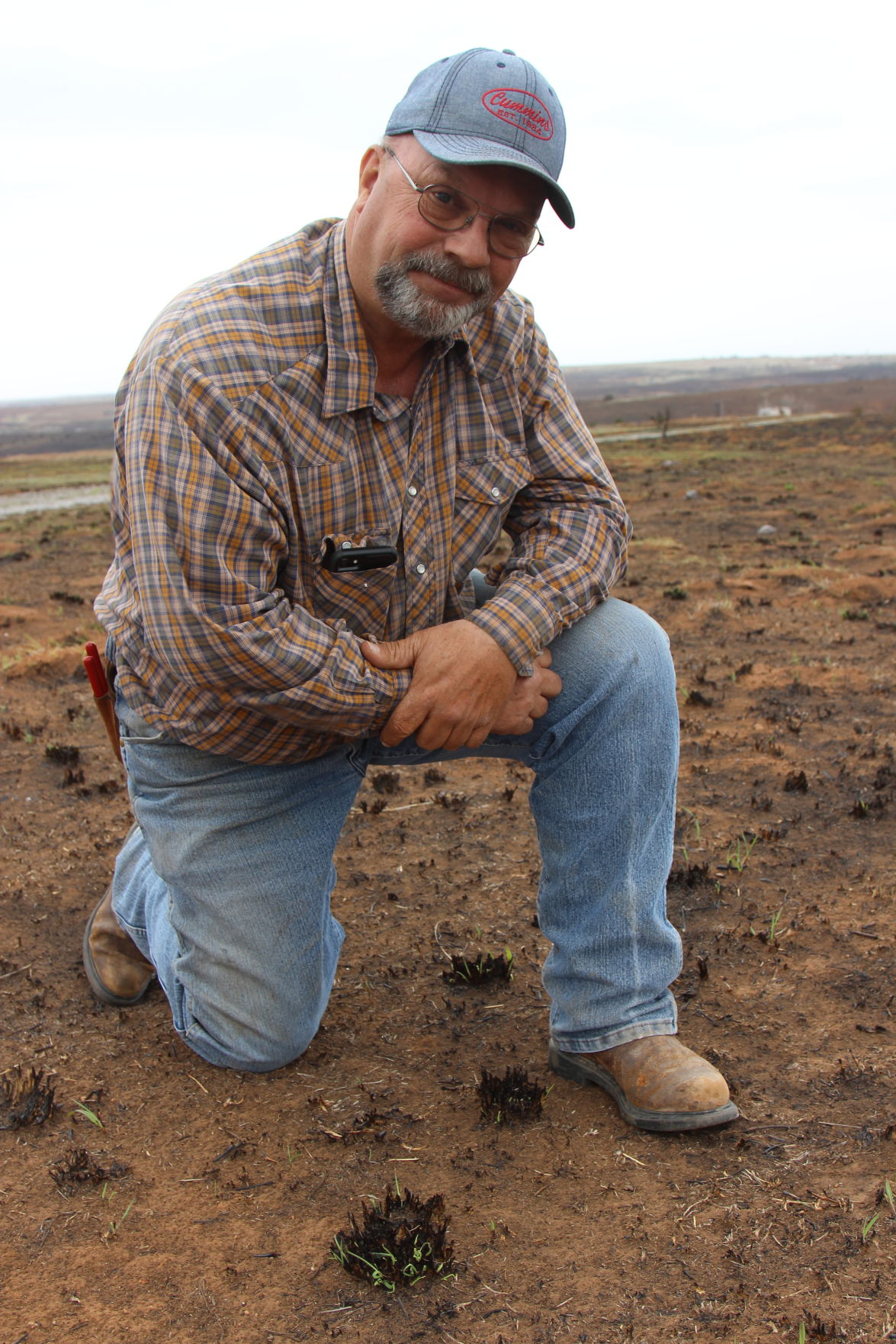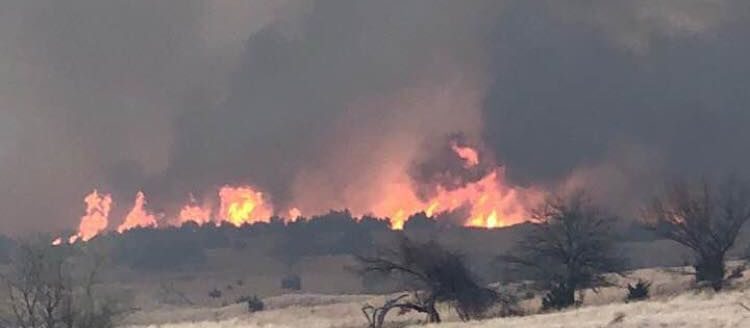The day was supposed to be a celebration of conservation.
On April 12, Jimmy and Ginger Emmons were in Oklahoma City, Oklahoma, at a luncheon thrown in their honor as recipients of the first Oklahoma Leopold Conservation Award. Midway through the meal, Jimmy’s cell phone started pinging with text messages from concerned neighbors. There was a fire that had been started by arcing power lines near Rhea, Oklahoma, but the wind seemed to be driving it north and away from their property near Leedey. The volunteer firefighters were out there and neighbors would keep them updated.
By dessert, the wind had changed, and Jimmy and Ginger were in their car racing home to take care of their ranch and cattle.
Thirteen days and 286,196 acres later, the Rhea Fire is now 99 percent contained. The Emmonses made it through several close calls with the flames. Providence and hard work saved their home and their cattle, but about 3,000 of their acres and one of their machine sheds burned. Jimmy pointed out where landmarks once stood on a short tour of Dewey County and spoke to the lessons that can be taken away from the fire.
Emergency responses
Jimmy is quick to thank the Oklahoma Forestry Services, the fire incident crews and the many volunteer fire departments that came to their aid. He and other ranchers were in daily contact with the local fire chief for updates.
What made this fire different than others Jimmy has experienced, he said, was the fuel load and the weather conditions. Low relative humidity in the 3 to 5 percent range, high fuel loads stressed by drought, combined with winds in the 70 mph range that would change directions daily, meant crews had changing lines at a moment’s notice. At its peak, the Rhea Fire, Jimmy said, was burning 118 acres a minute.
Jimmy told of one point where he and his crew had just moved a set of cattle to a wheat field and then the fire changed directions the next day and they needed to be moved again. His hired man had barely gotten the last cow moved and the gate shut before the fire was on top of him.
“I told him, next time, don’t worry about shutting the gate,” Jimmy said.
Another batch of cattle on another parcel found the one green spot closest to the pond and hunkered down while the flames surrounded them. Jimmy and his crew found them after the fire and they were OK.
“We were still looking for our bull when we got a call from a neighbor who was bulldozing a firebreak,” Jimmy said. “He said he turned around and there was our bull, following the tractor to safety.” Jimmy and his son got the bull into a trailer and out of danger.
The Emmonses are monitoring their herd, but so far they haven’t seen signs of smoke inhalation complications or singed feet or udders. They haven’t had a chance to match up cows and calves yet, and some cows were calving in the midst of the fires, but so far they seem to have all accounted for, Jimmy said.
“We had to make a decision, to either run the cattle through a chute and further stress them to see if they’ve got smoke damage, or to wait and let them rest and calm down and monitor them where they’re at,” Jimmy said.
Meanwhile, he has to keep feed in front of his cows. For now they have enough wheat and triticale pasture that didn’t burn that they can rotational graze until they can find grazing options that will bridge them until they can get forage grown again.
“I’ve got to find grass to send at least 150 cows,” Jimmy said. And while the hay donations have been a blessing, it’s not a long-term solution to keep feeding cattle on blackened ground with dust and ash if they’re to stay healthy. And the Emmonses aren’t the only ranchers who are going to be searching for grazing solutions while the pastures recover from the fires.
Jimmy said he hopes to be able to plant a forage mix on some of his acres, and if he can get it planted soon, he could have forage up and ready to graze in 45 to 55 days.
But he and his neighbors have to find a solution for grazing until then.
Conservation helped
Jimmy is a conservation and no-till advocate, which was one of the reasons why he was receiving the Leopold Conservation Award. He is the vice president of the No-till on the Plains board of directors. He also is the president of the Oklahoma Association of Conservation Districts and the vice president of the Dewey County Conservation District. Over the past two decades the Emmons family has converted to no-till, adopted crop rotations, and used cover crops and grazing management to increase water infiltration in their soil. But perhaps most importantly, they have been on a crusade against eastern red cedar trees, the scourge of much of western Oklahoma pastures.
“We had been doing a pretty good job on my grass controlling the cedars,” Jimmy said. But, where huge cedars had been left standing, it provided the wildfire with massive tinder dry fuel and high burning cedar oil. Jimmy pointed out on the map of the Rhea Fire where there was a fence line between one pasture that had a minimal amount of cedars next to one that was chock full of large old growth cedars.
In the acres covered with cedars, the intensity of the flames was much higher and the fire burned longer and hotter in places, Jimmy said.
The resiliency of the ground was on display as we toured. Over the previous weekend Dewey County received welcome rains that not only doused the fires, but also allowed the bluestem to put up hopeful green shoots.
“A part of our managed grazing is high density grazing, where we move the whole herd to graze 2 to 3 acres at a time for a short time,” Jimmy said. “Where we were doing that we expect the ground to recover better because the soil health, the infiltration rates, are better. Of course on the sandy ground it’ll be slower.”
As the land recovers from the fire, Jimmy plans to work with the Noble Foundation to implement more conservation methods that can help it bounce back quicker and better than before.
Recovery and moving forward
Thankfully, all of the Emmons family and crew came out unscathed. But others weren’t so lucky. Ranchers are still tallying the number of cattle killed, miles of fence ruined and the full extent of destruction.
Jimmy pointed out a neighbor who lost a shed with two combines, two large tractors, and his feed truck to the fire. He managed to save some of his cattle, but in order to feed them another neighbor was lending a feed truck with a bale spike. Jimmy said pulling together is what neighbors do in times of crisis, and that’s been on display through the flames and now that they’re dealing with the aftermath. From students and staff of the Leedey school district taking a day to help ranchers recover, to local businesses helping the community, to volunteers organizing hay donations, everyone has pulled together.
If there is any lesson to be learned from a disaster like this, it’s that ranching communities are as resilient as the land, Jimmy explained. As we toured, those shoots of green bluestem grasses peeking through the blackened earth brought some hope for the ranchers of Dewey County.
For Jimmy Emmons, that bit of green is as big of a reward as the Leopold trophy sitting on the desk at his house. It means that all of the conservation efforts over the last 20 years aren’t gone up in smoke and there’s hope for tomorrow and the days after.
And that’s worth celebrating.
Jennifer M. Latzke can be reached at 620-227-1807 or [email protected].




